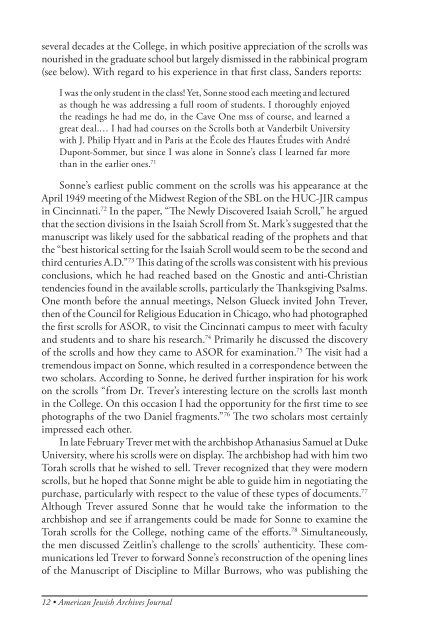The American Jewish Archives Journal, Volume LXI 2009, Number 1
The American Jewish Archives Journal, Volume LXI 2009, Number 1
The American Jewish Archives Journal, Volume LXI 2009, Number 1
Create successful ePaper yourself
Turn your PDF publications into a flip-book with our unique Google optimized e-Paper software.
several decades at the College, in which positive appreciation of the scrolls was<br />
nourished in the graduate school but largely dismissed in the rabbinical program<br />
(see below). With regard to his experience in that first class, Sanders reports:<br />
I was the only student in the class! Yet, Sonne stood each meeting and lectured<br />
as though he was addressing a full room of students. I thoroughly enjoyed<br />
the readings he had me do, in the Cave One mss of course, and learned a<br />
great deal.… I had had courses on the Scrolls both at Vanderbilt University<br />
with J. Philip Hyatt and in Paris at the École des Hautes Études with André<br />
Dupont-Sommer, but since I was alone in Sonne’s class I learned far more<br />
than in the earlier ones. 71<br />
Sonne’s earliest public comment on the scrolls was his appearance at the<br />
April 1949 meeting of the Midwest Region of the SBL on the HUC-JIR campus<br />
in Cincinnati. 72 In the paper, “<strong>The</strong> Newly Discovered Isaiah Scroll,” he argued<br />
that the section divisions in the Isaiah Scroll from St. Mark’s suggested that the<br />
manuscript was likely used for the sabbatical reading of the prophets and that<br />
the “best historical setting for the Isaiah Scroll would seem to be the second and<br />
third centuries A.D.” 73 This dating of the scrolls was consistent with his previous<br />
conclusions, which he had reached based on the Gnostic and anti-Christian<br />
tendencies found in the available scrolls, particularly the Thanksgiving Psalms.<br />
One month before the annual meetings, Nelson Glueck invited John Trever,<br />
then of the Council for Religious Education in Chicago, who had photographed<br />
the first scrolls for ASOR, to visit the Cincinnati campus to meet with faculty<br />
and students and to share his research. 74 Primarily he discussed the discovery<br />
of the scrolls and how they came to ASOR for examination. 75 <strong>The</strong> visit had a<br />
tremendous impact on Sonne, which resulted in a correspondence between the<br />
two scholars. According to Sonne, he derived further inspiration for his work<br />
on the scrolls “from Dr. Trever’s interesting lecture on the scrolls last month<br />
in the College. On this occasion I had the opportunity for the first time to see<br />
photographs of the two Daniel fragments.” 76 <strong>The</strong> two scholars most certainly<br />
impressed each other.<br />
In late February Trever met with the archbishop Athanasius Samuel at Duke<br />
University, where his scrolls were on display. <strong>The</strong> archbishop had with him two<br />
Torah scrolls that he wished to sell. Trever recognized that they were modern<br />
scrolls, but he hoped that Sonne might be able to guide him in negotiating the<br />
purchase, particularly with respect to the value of these types of documents. 77<br />
Although Trever assured Sonne that he would take the information to the<br />
archbishop and see if arrangements could be made for Sonne to examine the<br />
Torah scrolls for the College, nothing came of the efforts. 78 Simultaneously,<br />
the men discussed Zeitlin’s challenge to the scrolls’ authenticity. <strong>The</strong>se communications<br />
led Trever to forward Sonne’s reconstruction of the opening lines<br />
of the Manuscript of Discipline to Millar Burrows, who was publishing the<br />
12 • <strong>American</strong> <strong>Jewish</strong> <strong>Archives</strong> <strong>Journal</strong>

















